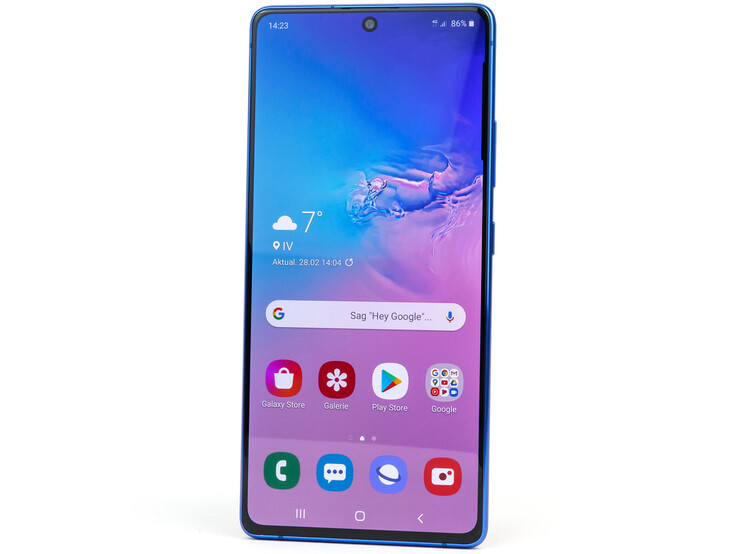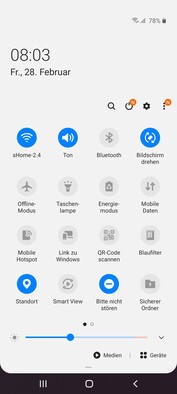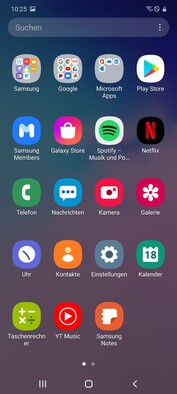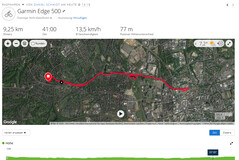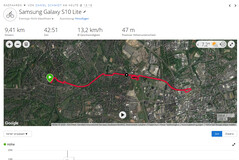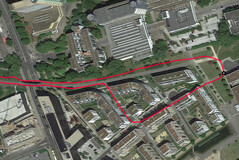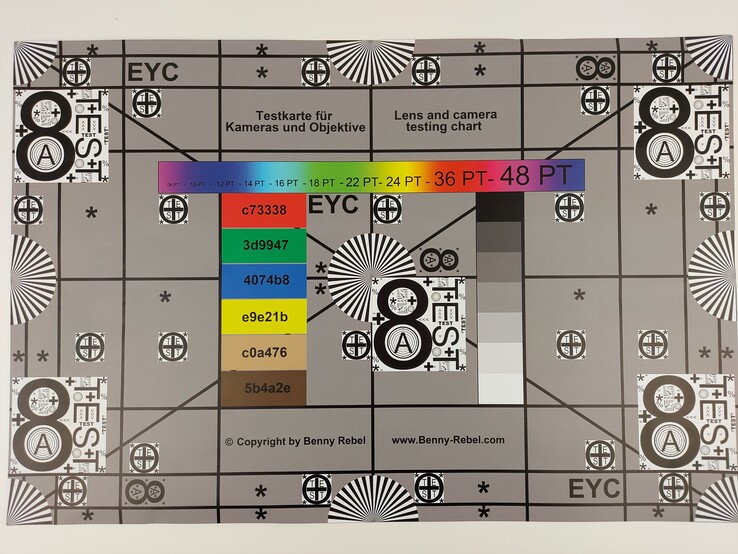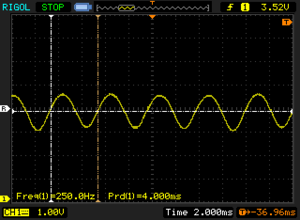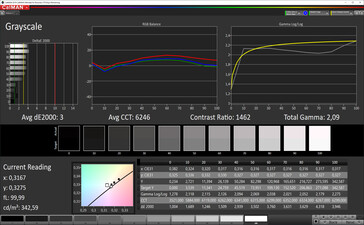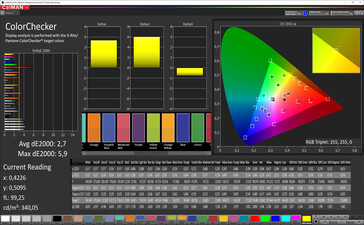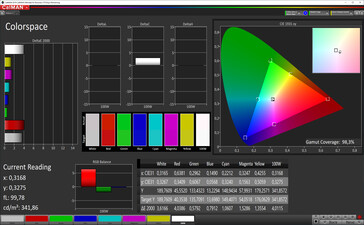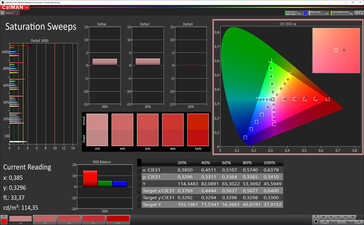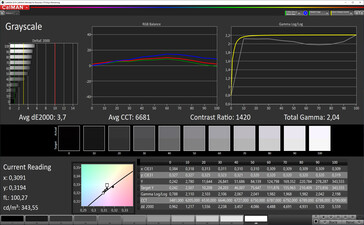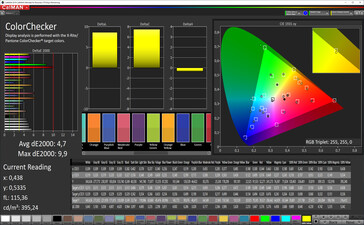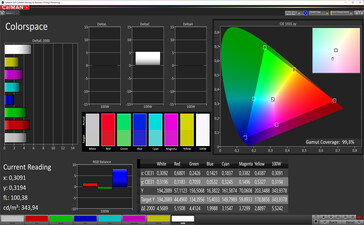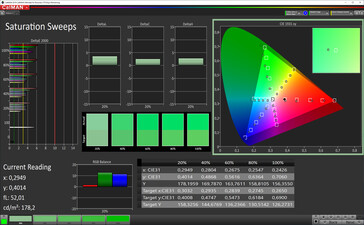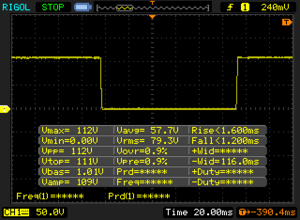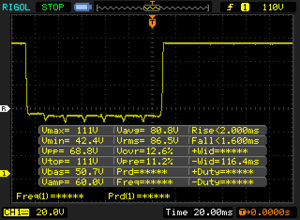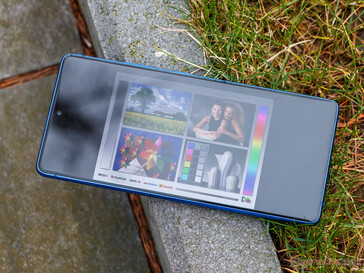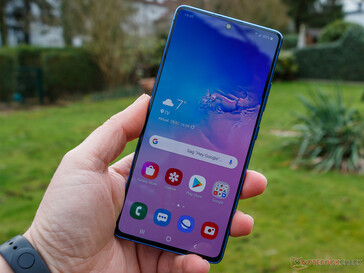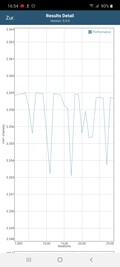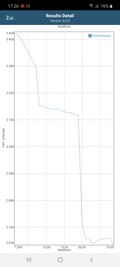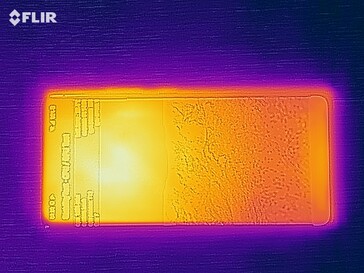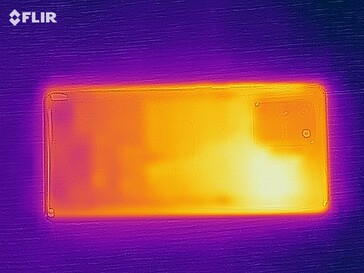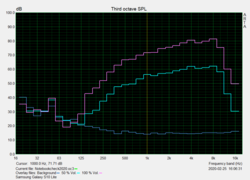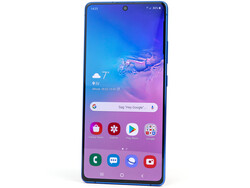Samsung Galaxy S10 Lite Review - Smartphone with a strong battery
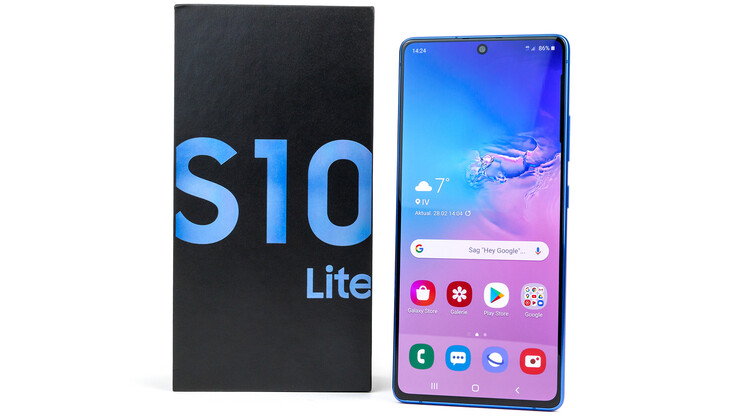
With a 6.7-inch Super AMOLED Plus display, the Samsung Galaxy S10 Lite (SM-G770F) is one of the larger smartphones. Unlike with other Galaxy S10 models, the Korean manufacturer no longer uses an Exynos chipset and instead relies on the Qualcomm Snapdragon 855, which primarily promises better efficiency. Combined with the 4,500-mAh battery, the Samsung phone is poised to achieve record runtimes.
The initial MSRP is $585. Since the siblings Galaxy S10 and Galaxy S10e can both be purchased at prices starting from 500 Euros (~$551), opting for the Lite version may be hard to justify. As history has shown however, the price is likely to drop below the 500-Euro threshold, making it an easier sell.
In this review, we determine whether buying the smartphone right now makes sense and what compromises were made compared to more expensive models.
Competing Devices
Rating | Date | Model | Weight | Drive | Size | Resolution | Price |
|---|---|---|---|---|---|---|---|
| 86 % v7 (old) | 02 / 2020 | Samsung Galaxy S10 Lite SD 855, Adreno 640 | 186 g | 128 GB UFS 3.0 Flash | 6.70" | 2400x1080 | |
| 87.4 % v7 (old) | 03 / 2019 | Samsung Galaxy S10 Exynos 9820, Mali-G76 MP12 | 157 g | 128 GB UFS 2.1 Flash | 6.10" | 3040x1440 | |
| 86.4 % v7 (old) | 05 / 2019 | Huawei P30 Kirin 980, Mali-G76 MP10 | 165 g | 128 GB UFS 2.1 Flash | 6.10" | 2340x1080 | |
| 86.2 % v7 (old) | 03 / 2019 | Xiaomi Mi 9 SD 855, Adreno 640 | 173 g | 64 GB UFS 2.1 Flash | 6.39" | 2340x1080 | |
| 85.7 % v7 (old) | 07 / 2019 | LG G8s ThinQ SD 855, Adreno 640 | 181 g | 128 GB UFS 2.1 Flash | 6.20" | 2248x1080 |
Case - A Lot of Glass and Colorful Options
The Galaxy S10 Lite has a solid metal frame and Corning Gorilla Glass 3 protection both on the back and the front. There are Prism Black, Prism Blue and Prism White color variants available. The white model is reminiscent of nacre and our blue test model looks more colorful in reality than in the advertisements.
The camera module on the back, which looks similar to the one on the Galaxy S20, immediately catches the eye. It protrudes from the case by exactly one millimeter. The build quality is excellent and the clearances are tight and even. The smartphone makes a very robust impression overall and responds to attempts at twisting with only minor creaking.
Even though the rubber seal on the SIM tray suggests otherwise, the S10 Lite is not protected against dust or water. The hybrid SIM module accepts either two nano-SIM cards or a microSD instead of the second SIM card. The battery cannot be replaced by the user.
Features - Galaxy Smartphone without Headphone Jack
Compared to other S10 models, the Galaxy Lite cuts a few corners in terms of the features. The USB Type-C port for example only allows for data transfers at USB 2.0 speeds and does not support wired video output or even Samsung's DeX. Similarly, there is no headphone jack and no barometer.
The storage can be expanded via a microSD card; all currently available form factors and capacities are supported. As per usual, the external storage cannot be formatted as internal storage and instead primarily serves as memory for multimedia or app data, part of which can be transferred over.
While the communications standard Bluetooth 5.0 nominally matches the one of the higher-end models and offers identical audio codec support (SBC, AAC, aptX and LDAC), the dual audio feature is missing.
There is no notification LED, since on the Galaxy S10 Lite the always-on display and the edge lighting take over its responsibilities instead.
Software - S10 Lite with Android 10
The Galaxy S10 Lite ships with the up-to-date operating system Android 10 and Samsung's own One UI 2.0. At the time of testing, the security patches date back to January 1, 2020, which is fairly recent. While speaking from experience, it is likely that the smartphone will receive updates to Android 11 and 12, Samsung has not yet officially confirmed this.
Aside from the Galaxy Store, there are numerous preinstalled apps such as a few from the Facebook group, Microsoft, Spotify and Netflix. Note that not all of them can be fully uninstalled. User account control is not active on the smartphone.
Communication and GNSS - S10 Lite with Wi-Fi 5 and Limited LTE
The first limitations become apparent after a glance at the specifications, since instead of Wi-Fi 6, the Galaxy S10 Lite only supports the older Wi-Fi 5 standard. As a test with our reference router Netgear Nighthawk AX12 shows, the MIMO antenna technology only comes into play when receiving data where it is fairly reliable, suggesting the absence of limitations during daily use.
When travelling, the S10 Lite can ideally connect to a mobile network via LTE and although the number of supported frequencies is lower compared to other S10 models, the most important bands for trips outside of Europe are included. The transfer speeds (Cat. 11) are lower than the theoretical maximum of the SoC.
| Networking | |
| iperf3 transmit AX12 | |
| Huawei P30 | |
| Samsung Galaxy S10 | |
| Xiaomi Mi 9 | |
| LG G8s ThinQ | |
| Samsung Galaxy S10 Lite | |
| iperf3 receive AX12 | |
| Xiaomi Mi 9 | |
| Samsung Galaxy S10 | |
| Samsung Galaxy S10 Lite | |
| LG G8s ThinQ | |
| Huawei P30 | |
The Galaxy S10 Lite supports the satellite systems GPS, Glonass, BeiDou, QZSS, Galileo as well as the complementary system SBAS. Even indoors, a satellite uplink is established relatively quickly and accurately.
We put the smartphone up against the Garmin Edge 500 by taking both devices with us on a bike ride. For a total distance of more than 9 kilometers, there is only a 160-meter difference, which is an acceptable result. Although a glance at the detailed track course reveals that the Galaxy smartphone tends to stray from the actual route, it is more than capable of handling navigation tasks.
Telephony and Call Quality
We were pleasantly surprised by the call quality of the Galaxy S10 Lite. Although the smartphone's microphone is slightly quieter than those of its competitors, the voices of both callers sound clear and present. Furthermore, the phone is able to filter out ambient noise very well. When using the speakerphone, the S10 Lite can be set down on a table without a dramatic loss in call quality and only a minor echo can be heard in addition to the user's voice.
The app is well-known by now and identical to its counterpart on other current Samsung smartphones. The smartphone also supports Wi-Fi calling and VoLTE.
Cameras - Triple-Camera Setup with Super Steady OIS
For the front, Samsung relies on a 32-MP camera with pixel binning, which produces pictures with a resolution of only 6.5 MP. The quality is fairly average. While the sharpness is decent, the colors appear slightly too pale. Videos can be captured at up to Ultra HD (30 FPS).
The main camera features a high-resolution 48 MP sensor as well as additional optics for ultra-wide angle and macro scenes. Zooming works digitally and thus sections from the original 48 MP image are used to achieve a maximum enhancement of 8x. Due to pixel binning, the final pictures have a resolution of 12 MP - there is no way to access the full resolution of the sensor, not even via the Pro mode.
In daylight, the quality of the pictures is good. The Galaxy S10 Lite shines with good contrast, a high degree of sharpness and a fairly wide dynamic range. Only the maximum zoom level shows that some details, which are not in focus, tend to get lost. Furthermore, the pictures show a faint red tint. In low-light scenarios, the S10 Lite can still capture a lot of light, although this comes at a cost to the level of detail. Contours then become uniform color areas.
Samsung has put a lot of effort into the video-recording performance and although the Samsung phone can only capture videos at up to 2,160p at 30 FPS, the real star of the show is the Super Steady image stabilizer, which promises stabilization similar to that of action cams. While we are familiar with this feature from the Moto Action, the Korean manufacturer continues to favor landscape mode. The video resolution is limited to 1920x1080 pixels (Full HD, 30 FPS). While the image stabilization works fairly well itself, the video quality suffers as a result and image noise becomes apparent even under good lighting conditions. Videos look much better without Super OIS, however. Audio is captured clearly and with a low amount of static.
Under controlled lighting conditions, the warm nature of the color balance becomes immediately apparent. Colors appear very bright and only yellow and black are represented in a fairly natural manner.
As our test chart shows, the sharpness in the center of the image is high. Similarly, colored areas are accurately represented and text on a dark background barely becomes frayed. While the sharpness and contrast decrease towards the edges, the falloff is nothing out of the ordinary.
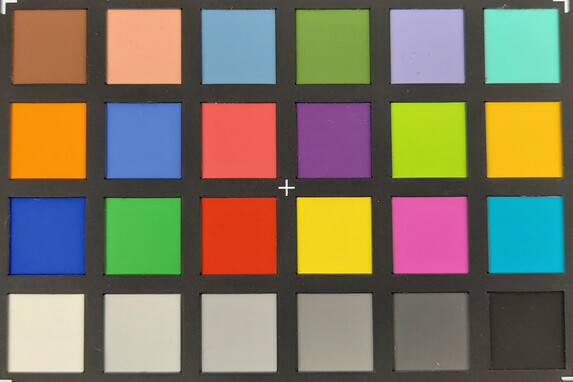

Accessories and Warranty - Optional Care+
The Galaxy S10 Lite's scope of delivery includes a modular USB Type-C quick charger (5 V - 3 A, 9 V - 2.77 A), a USB cable (USB Type-C to USB Type-C), a SIM tool, a headset, and some paperwork.
In addition to the standard warranty period of 24 months, the manufacturer offers a Care+ insurance (149 Euros or ~$164) for cheaper repairs. Covers designed specifically for the Galaxy S10 Lite can be purchased separately as well.
Input Devices & Handling - Galaxy Phone with Fingerprint Sensor below the Display
The capacitive touchscreen of the Samsung Galaxy S10 Lite possesses very comfortable gliding properties and quickly and reliably responds to inputs. The power button is not only used for switching the device or display on and off but also for activating Bixby.
The smartphone can be biometrically protected by 2D facial recognition and although it was not among the fastest in our comparison, it proved to be very reliable. In order to further increase the security, the precision of the recognition can be increased at the cost of a more time-intensive unlock. Alternatively or additionally, the fingerprint sensor below the display, which features a decent recognition rate, can be used, although it takes a moment for it to fulfill its task.
Display - Galaxy S10 Lite with Bright OLED Screen
The Super AMOLED Plus display of the Galaxy S10 Lite measures 6.7 inches diagonally and while it only offers FHD+ resolution, we appreciate its high luminosity. Particularly compared to the Galaxy S10e, Samsung has improved the display's brightness by quite a bit. In the APL50 test, the panel reaches up to 807 cd/m² in the center or up to 347 cd/m² with the ambient light sensor disabled.
Thanks to the underlying OLED technology, the black value is absolute, theoretically resulting in a contrast ratio that approaches infinity. Relying on pulse-width modulation for controlling the display's brightness is also common for OLEDs, and in this case the S10 Lite's PWM frequency fluctuates between 235.8 and 250.0 Hz. Since features such as DC dimming are not available, sensitive users may experience issues.
| |||||||||||||||||||||||||
Brightness Distribution: 96 %
Center on Battery: 622 cd/m²
Contrast: ∞:1 (Black: 0 cd/m²)
ΔE ColorChecker Calman: 2.7 | ∀{0.5-29.43 Ø4.77}
ΔE Greyscale Calman: 3 | ∀{0.09-98 Ø5}
98.3% sRGB (Calman 2D)
Gamma: 2.09
CCT: 6246 K
| Samsung Galaxy S10 Lite Super AMOLED Plus, 2400x1080, 6.7" | Samsung Galaxy S10 OLED, 3040x1440, 6.1" | Samsung Galaxy S10e AMOLED, 2280x1080, 5.8" | Huawei P30 OLED, 2340x1080, 6.1" | Xiaomi Mi 9 AMOLED, 2340x1080, 6.4" | LG G8s ThinQ P-OLED, 2248x1080, 6.2" | |
|---|---|---|---|---|---|---|
| Screen | -5% | 7% | 20% | 28% | -11% | |
| Brightness middle (cd/m²) | 622 | 701 13% | 426 -32% | 561 -10% | 593 -5% | 539 -13% |
| Brightness (cd/m²) | 630 | 705 12% | 427 -32% | 560 -11% | 587 -7% | 556 -12% |
| Brightness Distribution (%) | 96 | 98 2% | 96 0% | 95 -1% | 94 -2% | 88 -8% |
| Black Level * (cd/m²) | ||||||
| Colorchecker dE 2000 * | 2.7 | 3.7 -37% | 2.14 21% | 1.5 44% | 0.9 67% | 3.78 -40% |
| Colorchecker dE 2000 max. * | 5.9 | 10.3 -75% | 3.29 44% | 2.5 58% | 2 66% | 6.95 -18% |
| Greyscale dE 2000 * | 3 | 1.4 53% | 1.8 40% | 1.8 40% | 1.5 50% | 2.2 27% |
| Gamma | 2.09 105% | 2.1 105% | 2.111 104% | 2.2 100% | 2.27 97% | 2.274 97% |
| CCT | 6246 104% | 6553 99% | 6329 103% | 6512 100% | 6548 99% | 6013 108% |
* ... smaller is better
Screen Flickering / PWM (Pulse-Width Modulation)
| Screen flickering / PWM detected | 250 Hz | ≤ 99 % brightness setting | |
The display backlight flickers at 250 Hz (worst case, e.g., utilizing PWM) Flickering detected at a brightness setting of 99 % and below. There should be no flickering or PWM above this brightness setting. The frequency of 250 Hz is relatively low, so sensitive users will likely notice flickering and experience eyestrain at the stated brightness setting and below. In comparison: 53 % of all tested devices do not use PWM to dim the display. If PWM was detected, an average of 8088 (minimum: 5 - maximum: 343500) Hz was measured. | |||
We further examined the color accuracy of the panel with the analysis software CalMAN and a spectrophotometer. While the Lite only uses the smaller sRGB color space in the default mode natural, the latter provides a good color representation and is the most accurate compared to the other modes. In vivid mode, the wider DCI-P3 color space is used and the color temperature becomes cooler overall, although this can be adjusted manually. While the quality is fairly good, professional users may notice a deviation from the reference colors in a few cases.
Display Response Times
| ↔ Response Time Black to White | ||
|---|---|---|
| 2.8 ms ... rise ↗ and fall ↘ combined | ↗ 1.6 ms rise | |
| ↘ 1.2 ms fall | ||
| The screen shows very fast response rates in our tests and should be very well suited for fast-paced gaming. In comparison, all tested devices range from 0.1 (minimum) to 240 (maximum) ms. » 12 % of all devices are better. This means that the measured response time is better than the average of all tested devices (20.2 ms). | ||
| ↔ Response Time 50% Grey to 80% Grey | ||
| 3.6 ms ... rise ↗ and fall ↘ combined | ↗ 2 ms rise | |
| ↘ 1.6 ms fall | ||
| The screen shows very fast response rates in our tests and should be very well suited for fast-paced gaming. In comparison, all tested devices range from 0.165 (minimum) to 636 (maximum) ms. » 13 % of all devices are better. This means that the measured response time is better than the average of all tested devices (31.6 ms). | ||
Performance - Like the Wind
The Snapdragon 855 inside the Galaxy S10 Lite was commonly found in many high-end smartphones from 2019. On top of that, Samsung installs a generous 8 GB of LPDDR4x RAM. Thus, the achieved performance level is high.
The smartphone does not struggle with our benchmarks and the results match our expectations. The system performance is very high and noticeable stutters are exceedingly rare.
| PCMark for Android | |
| Work performance score (sort by value) | |
| Samsung Galaxy S10 Lite | |
| Samsung Galaxy S10 | |
| Huawei P30 | |
| Xiaomi Mi 9 | |
| LG G8s ThinQ | |
| Average Qualcomm Snapdragon 855 (10330 - 14439, n=19) | |
| Work 2.0 performance score (sort by value) | |
| Samsung Galaxy S10 Lite | |
| Samsung Galaxy S10 | |
| Huawei P30 | |
| Xiaomi Mi 9 | |
| LG G8s ThinQ | |
| Average Qualcomm Snapdragon 855 (8342 - 11440, n=19) | |
| GFXBench 3.1 | |
| on screen Manhattan ES 3.1 Onscreen (sort by value) | |
| Samsung Galaxy S10 Lite | |
| Samsung Galaxy S10 | |
| Huawei P30 | |
| Xiaomi Mi 9 | |
| LG G8s ThinQ | |
| Average Qualcomm Snapdragon 855 (27 - 58, n=20) | |
| Average of class Smartphone (11 - 166, n=156, last 2 years) | |
| 1920x1080 Manhattan ES 3.1 Offscreen (sort by value) | |
| Samsung Galaxy S10 Lite | |
| Samsung Galaxy S10 | |
| Huawei P30 | |
| Xiaomi Mi 9 | |
| LG G8s ThinQ | |
| Average Qualcomm Snapdragon 855 (35 - 71, n=20) | |
| Average of class Smartphone (8.4 - 413, n=155, last 2 years) | |
| AnTuTu v8 - Total Score (sort by value) | |
| Samsung Galaxy S10 Lite | |
| Xiaomi Mi 9 | |
| LG G8s ThinQ | |
| Average Qualcomm Snapdragon 855 (376698 - 451559, n=8) | |
The S10 Lite performs well in terms of web browsing as well and loads web pages quickly. In our benchmarks, it achieves an outstandingly high result in Jetstream, whereas the results are mostly average otherwise.
| Jetstream 2 - 2.0 Total Score | |
| Average of class Smartphone (23.8 - 387, n=148, last 2 years) | |
| Samsung Galaxy S10 Lite (Chrome 80) | |
| Average Qualcomm Snapdragon 855 (45.5 - 67, n=16) | |
| Xiaomi Mi 9 (Chrome 73) | |
| LG G8s ThinQ (Chrome 75) | |
| Huawei P30 (Chrome 73) | |
| JetStream 1.1 - Total Score | |
| Samsung Galaxy S10 Lite (Chrome 80) | |
| Xiaomi Mi 9 (Chrome 73.0.3683.75) | |
| Average Qualcomm Snapdragon 855 (84.4 - 120, n=17) | |
| Huawei P30 (Chrome 73) | |
| LG G8s ThinQ (Chrome 75) | |
| Samsung Galaxy S10 (Samsung Browser 9.0) | |
| Speedometer 2.0 - Result 2.0 | |
| Average of class Smartphone (15.2 - 643, n=121, last 2 years) | |
| Xiaomi Mi 9 (Chrome 73.0.3683.75) | |
| LG G8s ThinQ (Chome 75) | |
| Samsung Galaxy S10 Lite (Chrome 80) | |
| Average Qualcomm Snapdragon 855 (42.5 - 67.9, n=15) | |
| Huawei P30 (Chrome 73) | |
| Samsung Galaxy S10 (Samsung Browser 9.0) | |
| WebXPRT 3 - Overall | |
| Average of class Smartphone (38 - 380, n=31, last 2 years) | |
| Xiaomi Mi 9 (Chrome 73.0.3683.75) | |
| LG G8s ThinQ (Chrome 75) | |
| Average Qualcomm Snapdragon 855 (90 - 129, n=20) | |
| Samsung Galaxy S10 Lite (Chrome 80) | |
| Huawei P30 (Chrome 73) | |
| Octane V2 - Total Score | |
| Average of class Smartphone (2228 - 121337, n=195, last 2 years) | |
| Xiaomi Mi 9 (Chrome 73.0.3683.75) | |
| LG G8s ThinQ (Chrome 75) | |
| Average Qualcomm Snapdragon 855 (17011 - 33918, n=21) | |
| Samsung Galaxy S10 Lite (Chrome 80) | |
| Huawei P30 (Chrome 73) | |
| Samsung Galaxy S10 (Samsung Browser 9.0) | |
| Mozilla Kraken 1.1 - Total | |
| Average Qualcomm Snapdragon 855 (1852 - 2611, n=19) | |
| Samsung Galaxy S10 Lite (Chrome 80) | |
| Huawei P30 (Chrome 73) | |
| LG G8s ThinQ (Chrome 75) | |
| Samsung Galaxy S10 (Samsung Browser 9.0) | |
| Xiaomi Mi 9 (Chrome 73.0.3683.75) | |
| Average of class Smartphone (257 - 28190, n=154, last 2 years) | |
* ... smaller is better
The memory of the Galaxy S10 Lite is a real highlight, since Samsung has opted to install cutting-edge UFS 3.0 storage, which performs consistently well according to our tests.
By contrast, the microSD card slot does not achieve particularly good results in conjunction with our reference card Toshiba Exceria Pro M501 and is one of the slower models within its price class.
| Samsung Galaxy S10 Lite | Samsung Galaxy S10 | Huawei P30 | Xiaomi Mi 9 | LG G8s ThinQ | Average 128 GB UFS 3.0 Flash | Average of class Smartphone | |
|---|---|---|---|---|---|---|---|
| AndroBench 3-5 | -35% | -16% | -27% | -43% | 1% | 114% | |
| Sequential Read 256KB (MB/s) | 1489 | 832 -44% | 909 -39% | 666 -55% | 791 -47% | 1520 ? 2% | 2243 ? 51% |
| Sequential Write 256KB (MB/s) | 525 | 193.2 -63% | 186 -65% | 388.3 -26% | 182.4 -65% | 546 ? 4% | 1865 ? 255% |
| Random Read 4KB (MB/s) | 191.7 | 137.4 -28% | 138.8 -28% | 149.4 -22% | 138 -28% | 206 ? 7% | 296 ? 54% |
| Random Write 4KB (MB/s) | 173.5 | 24.44 -86% | 195.3 13% | 165.3 -5% | 29.6 -83% | 193.9 ? 12% | 339 ? 95% |
| Sequential Read 256KB SDCard (MB/s) | 76 ? | 77.9 ? 3% | 82.8 ? 9% | 67.5 ? -11% | 67.3 ? -11% | ||
| Sequential Write 256KB SDCard (MB/s) | 61 ? | 64.8 ? 6% | 71.3 ? 17% | 46.7 ? -23% | 55.7 ? -9% |
Gaming - Adreno 640 as a Powerful Backbone
With the Galaxy S10 Lite's Adreno 640, all current games from the Google Play Store can be played. We confirmed this with the help of GameBench and two titles. While there were occasional frame drops during Asphalt 9, PUBG Mobile ran without any issues even at the highest frame rate.
The large display is a real asset when it comes to gaming. Unfortunately, it is easy to accidentally block the speaker on the bottom edge.
Emissions - Samsung Galaxy with Mono Speaker
Temperature
The surface temperatures are very low while idling, and even under load only a few spots become lukewarm.
With GFXBench's battery test, we monitor the SoC's behavior under prolonged load. In this test, we run each benchmark scenario 30 times in succession and record the battery level as well as the frame rates. While the Lite is able to complete the older T-Rex test (OpenGL ES 2.0) without any issues, its initial performance drops by as much as 30% over the course of the more-demanding Manhattan test (OpenGL ES 3.1).
(+) The maximum temperature on the upper side is 35.1 °C / 95 F, compared to the average of 35.2 °C / 95 F, ranging from 21.9 to 247 °C for the class Smartphone.
(+) The bottom heats up to a maximum of 36.3 °C / 97 F, compared to the average of 34 °C / 93 F
(+) In idle usage, the average temperature for the upper side is 28 °C / 82 F, compared to the device average of 32.9 °C / 91 F.
Speaker
The mono speaker on the bottom edge of the Samsung Galaxy S10 Lite can become very loud. While the mids sound relatively balanced, higher frequencies are too prominent, which results in an unbalanced, hollow sound particularly at higher volumes. Since this effect is barely noticeable at medium volume, the smartphone's sound reproduction is still decent overall, although it is somewhat regrettable that Samsung did not integrate a dual speaker solution.
The included earphones fell victim to cost-saving measures as well, and as a result the included model has not been optimized by AKG.
Samsung Galaxy S10 Lite audio analysis
(+) | speakers can play relatively loud (88.9 dB)
Bass 100 - 315 Hz
(-) | nearly no bass - on average 30% lower than median
(±) | linearity of bass is average (11.4% delta to prev. frequency)
Mids 400 - 2000 Hz
(+) | balanced mids - only 3.4% away from median
(+) | mids are linear (3.9% delta to prev. frequency)
Highs 2 - 16 kHz
(±) | higher highs - on average 6.9% higher than median
(+) | highs are linear (4% delta to prev. frequency)
Overall 100 - 16.000 Hz
(±) | linearity of overall sound is average (22% difference to median)
Compared to same class
» 45% of all tested devices in this class were better, 7% similar, 48% worse
» The best had a delta of 11%, average was 35%, worst was 134%
Compared to all devices tested
» 63% of all tested devices were better, 6% similar, 31% worse
» The best had a delta of 4%, average was 24%, worst was 134%
Huawei P30 audio analysis
(+) | speakers can play relatively loud (82.4 dB)
Bass 100 - 315 Hz
(-) | nearly no bass - on average 17.5% lower than median
(±) | linearity of bass is average (11.6% delta to prev. frequency)
Mids 400 - 2000 Hz
(±) | higher mids - on average 5.3% higher than median
(+) | mids are linear (5.3% delta to prev. frequency)
Highs 2 - 16 kHz
(±) | higher highs - on average 7.8% higher than median
(+) | highs are linear (5.3% delta to prev. frequency)
Overall 100 - 16.000 Hz
(±) | linearity of overall sound is average (21.5% difference to median)
Compared to same class
» 42% of all tested devices in this class were better, 8% similar, 50% worse
» The best had a delta of 11%, average was 35%, worst was 134%
Compared to all devices tested
» 60% of all tested devices were better, 7% similar, 33% worse
» The best had a delta of 4%, average was 24%, worst was 134%
Battery Life - It Keeps Going...
Energy Consumption
The energy consumption of the Galaxy S10 Lite is fairly low and does not warrant criticism. Additionally, the charger only draws 0.0033 watts during idle, making it very economical.
Unfortunately, the S10 Lite does not support wireless charging.
| Off / Standby | |
| Idle | |
| Load |
|
Key:
min: | |
| Samsung Galaxy S10 Lite 4500 mAh | Samsung Galaxy S10 3400 mAh | Huawei P30 3650 mAh | Xiaomi Mi 9 3300 mAh | LG G8s ThinQ 3550 mAh | Average Qualcomm Snapdragon 855 | Average of class Smartphone | |
|---|---|---|---|---|---|---|---|
| Power Consumption | -3% | -21% | 4% | -35% | -18% | -28% | |
| Idle Minimum * (Watt) | 0.58 | 0.61 -5% | 0.69 -19% | 0.67 -16% | 1.2 -107% | 0.939 ? -62% | 0.843 ? -45% |
| Idle Average * (Watt) | 1.55 | 1.27 18% | 2.41 -55% | 1.26 19% | 1.6 -3% | 1.506 ? 3% | 1.436 ? 7% |
| Idle Maximum * (Watt) | 1.64 | 1.3 21% | 2.51 -53% | 1.29 21% | 2 -22% | 1.799 ? -10% | 1.62 ? 1% |
| Load Average * (Watt) | 4.29 | 6.17 -44% | 3.86 10% | 3.71 14% | 5 -17% | 4.61 ? -7% | 7.04 ? -64% |
| Load Maximum * (Watt) | 8.03 | 8.55 -6% | 6.96 13% | 9.3 -16% | 10 -25% | 9.04 ? -13% | 11.3 ? -41% |
* ... smaller is better
Battery Life
While the 4,500-mAh battery promises long battery life, some other models have shown that this foregone conclusion is not always correct and the Galaxy S10 series is already somewhat infamous for its relatively weak runtimes.
However, the Galaxy S10 Lite breaks the trend by offering long battery life across the board. The smartphone performs particularly well in our real-world Wi-Fi test, where it also beats models from other manufacturers.
Additionally, the S10 Lite supports super fast charging at up to 45 watts, although an appropriate charger is not included and has to be purchased separately.
| Samsung Galaxy S10 Lite 4500 mAh | Samsung Galaxy S10 3400 mAh | Huawei P30 3650 mAh | Xiaomi Mi 9 3300 mAh | LG G8s ThinQ 3550 mAh | |
|---|---|---|---|---|---|
| Battery runtime | -38% | -13% | -24% | -23% | |
| Reader / Idle (h) | 41.7 | 21 -50% | 31.9 -24% | 27.5 -34% | 28.2 -32% |
| H.264 (h) | 19.7 | 14 -29% | 17.5 -11% | 16.8 -15% | 12.6 -36% |
| WiFi v1.3 (h) | 13.7 | 7.1 -48% | 11.9 -13% | 9.1 -34% | 11.6 -15% |
| Load (h) | 3.7 | 2.8 -24% | 3.5 -5% | 3.2 -14% | 3.4 -8% |
Pros
Cons
Verdict - Power, Finally
The Samsung Galaxy S10 Lite is more than meets the eye, since it is not just a cheap version of the nominally more expensive S10 models. First and foremost, it is now finally able to deliver convincing battery life, which is something it primarily owes to the large battery but also in part to the fact that an Exynos processor is no longer used. In this major category, none of the supposed Lite model's siblings manage to look very good in comparison.
However, a few compromises had to be made, resulting in the S10 Lite's lower display resolution compared to flagship devices and the omission of modern communication standards such as Wi-Fi 6 or 5G. Additionally, the Korean manufacturer has cut the Bluetooth dual audio feature and wireless charging.
While the Galaxy S10 Lite may not be the best Galaxy S10 model, it does have the most stamina. This makes the lack of a few features easy to overlook.
As for the camera, Samsung has chosen a different path that shines a light on the cheaper nature of the phone. Although the S10 Lite's camera resolution is higher, the image quality of the cameras falls short of those of other S10 models with a modular aperture. Similarly, corners have been cut when it comes to the front camera, since high megapixel counts were prioritized over quality and there is no autofocus. Although the Super Steady OIS is decent, the image quality degradation it incurs is too high. Overall, the S10 Lite's camera quality is still good, although it is clearly unable to match its higher-end siblings.
Samsung does not give prospective buyers an easy choice, particularly at the current prices. While the Galaxy S10 is simply cheaper, we advise against the S10e at its current price. The Galaxy S10 Lite may already be the right choice for users who are interested in a large display and the very long battery life in particular and also less enchanted by the other models' high-end features. For everyone else, we recommend being patient for a couple of months, since this smartphone will likely fall in price and presumably be on offer for less than $500 in the very near future.
Samsung Galaxy S10 Lite
- 09/03/2022 v7 (old)
Daniel Schmidt




